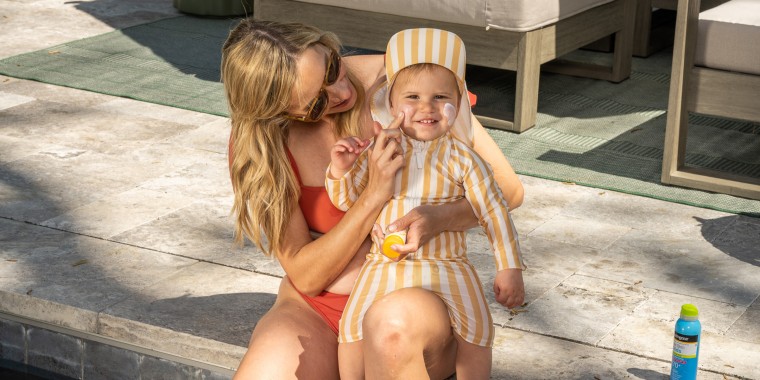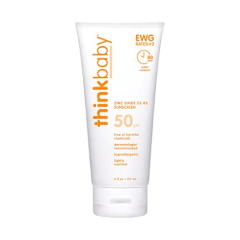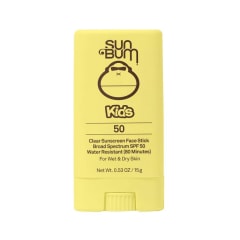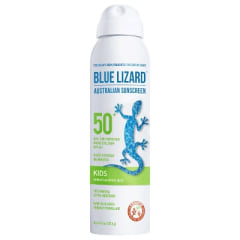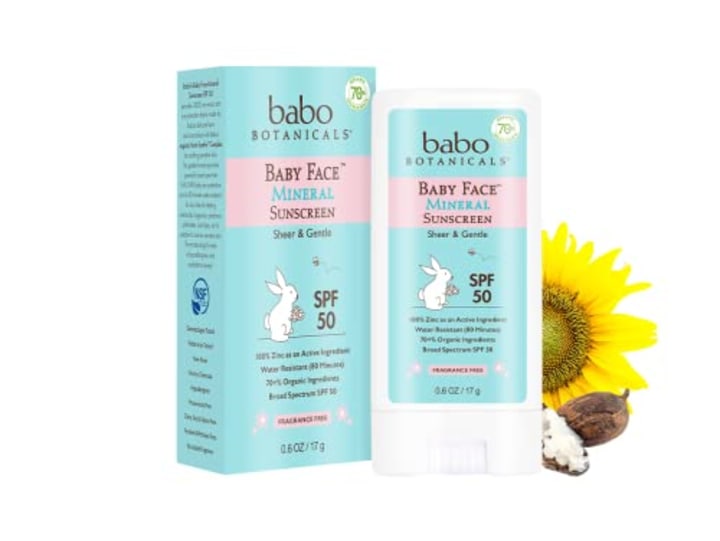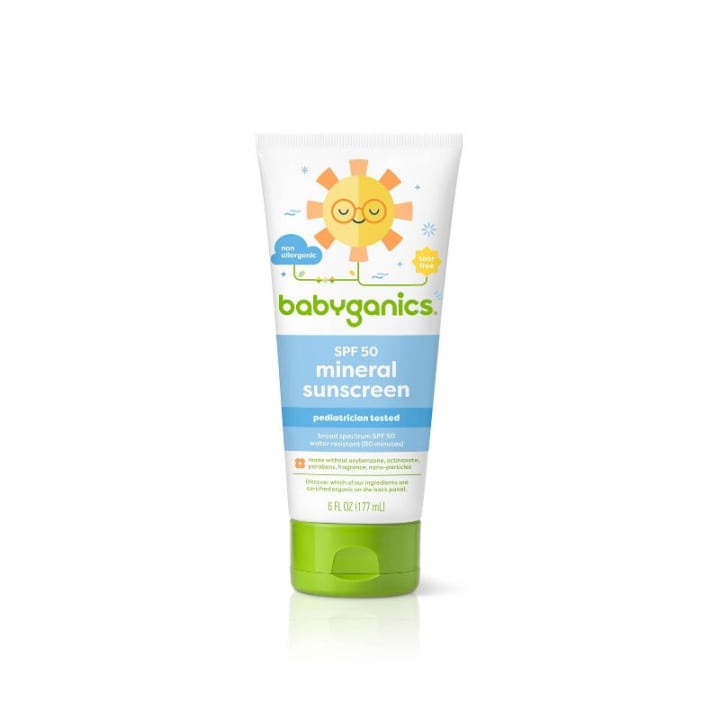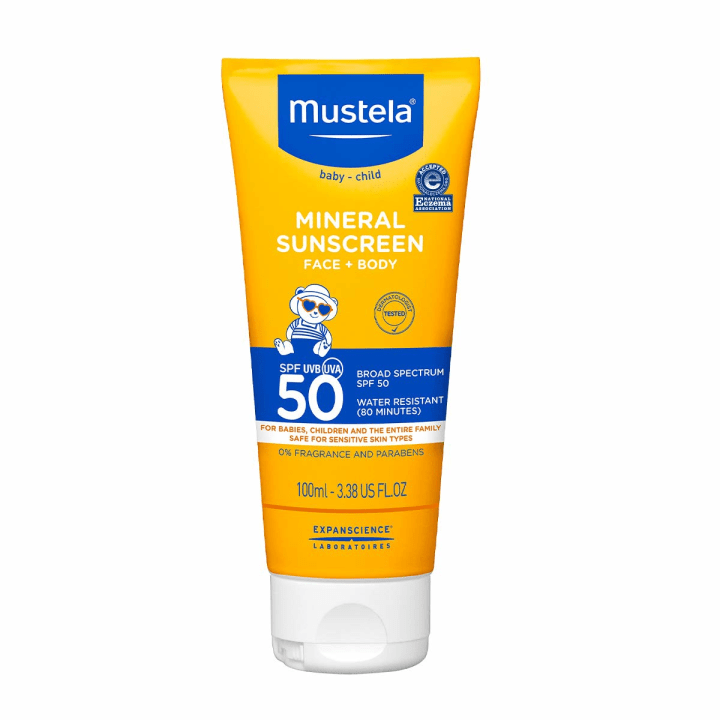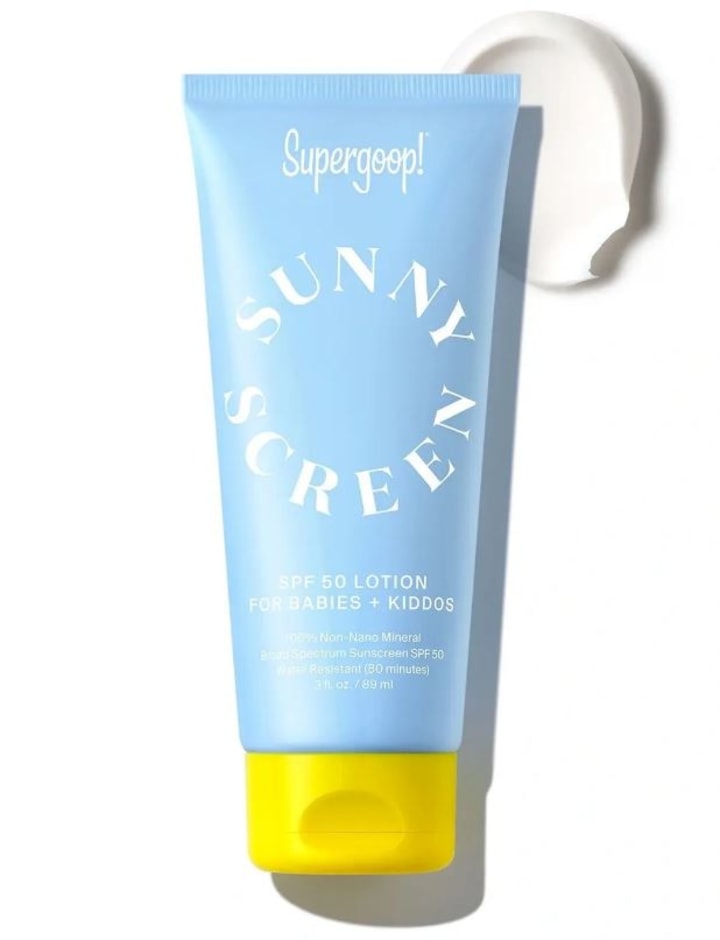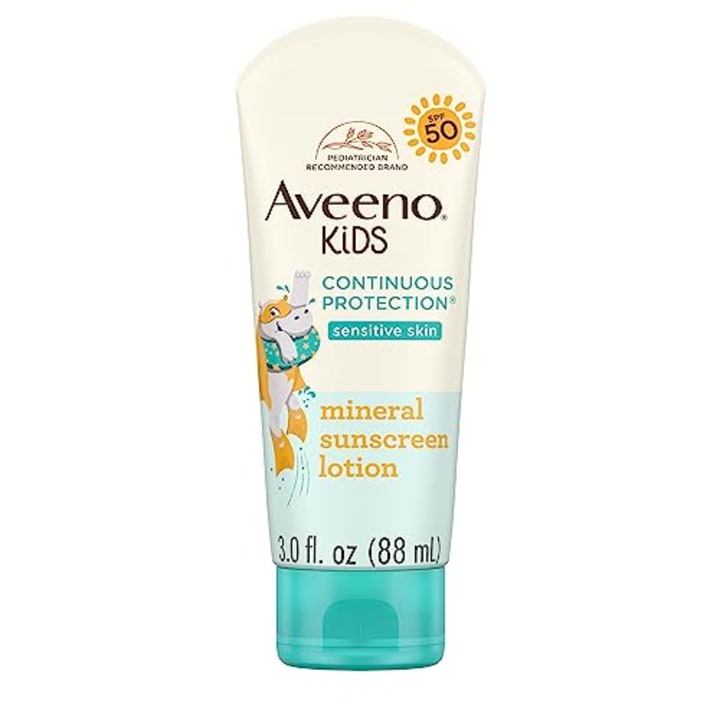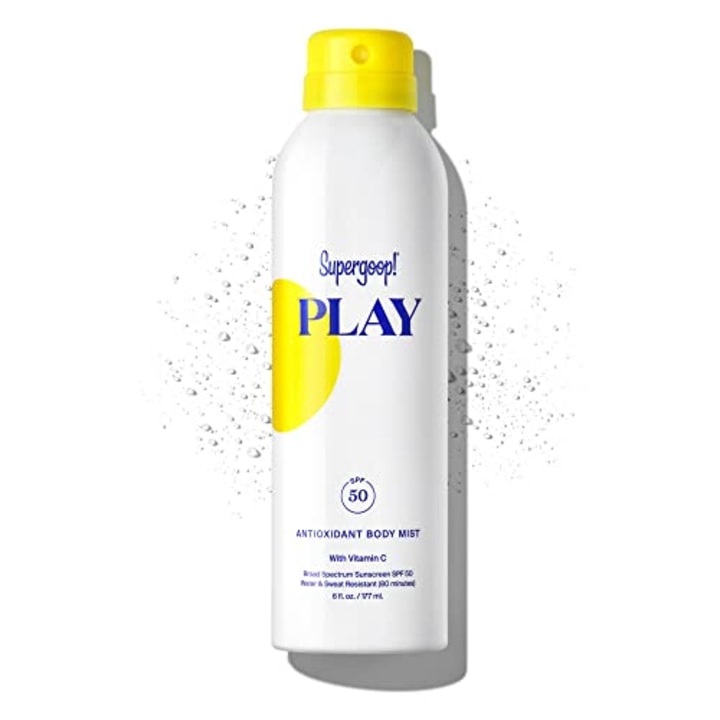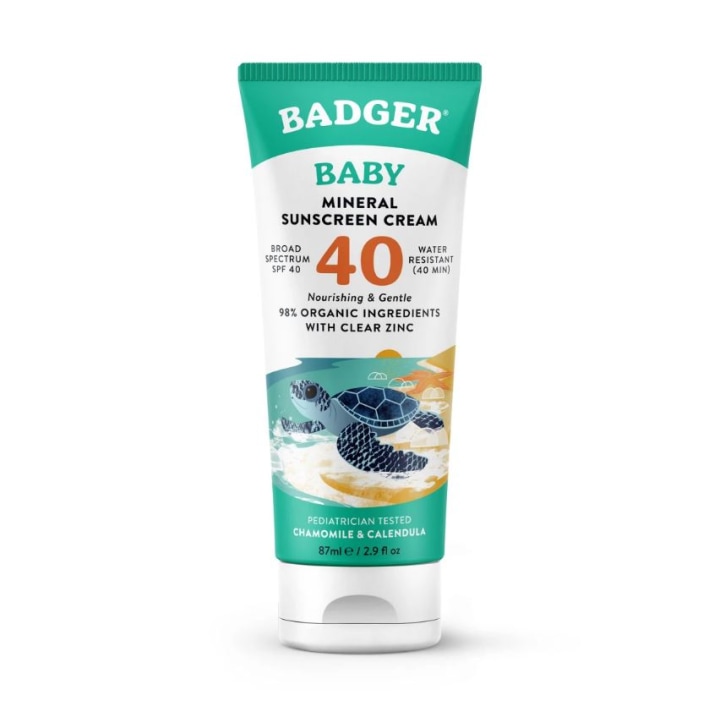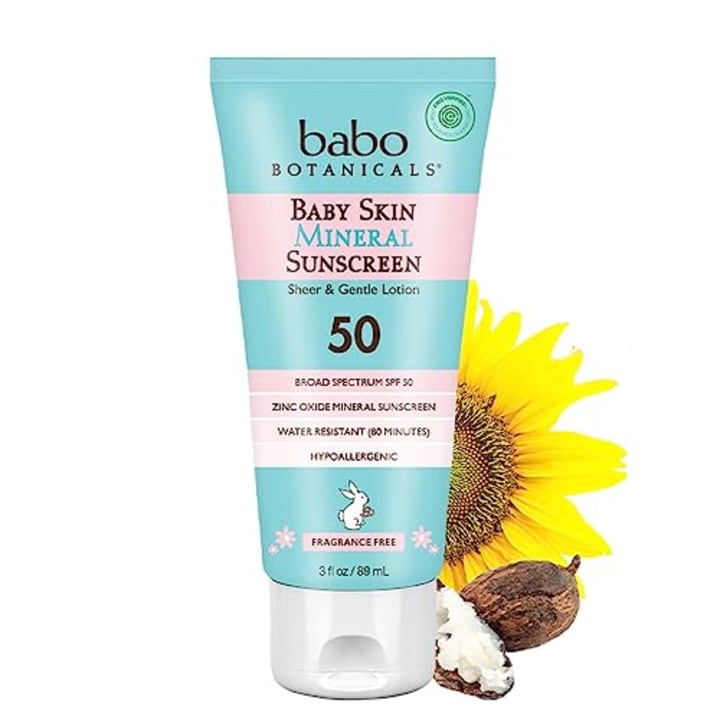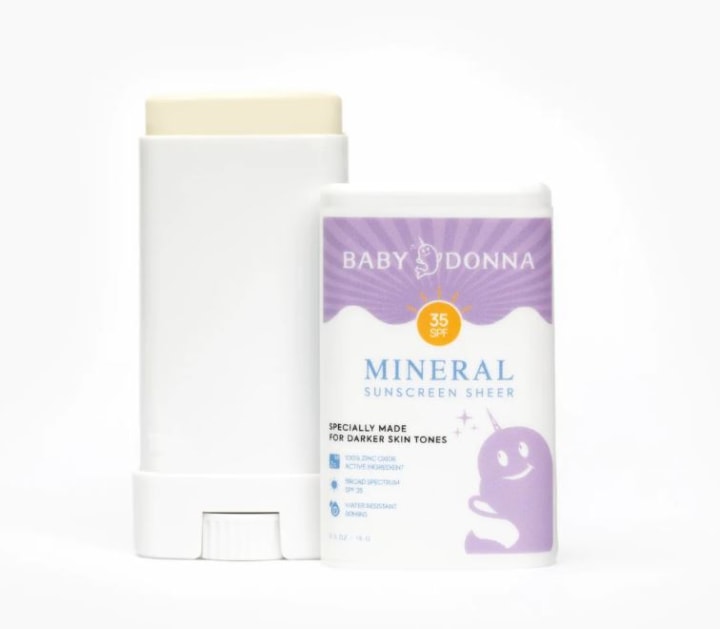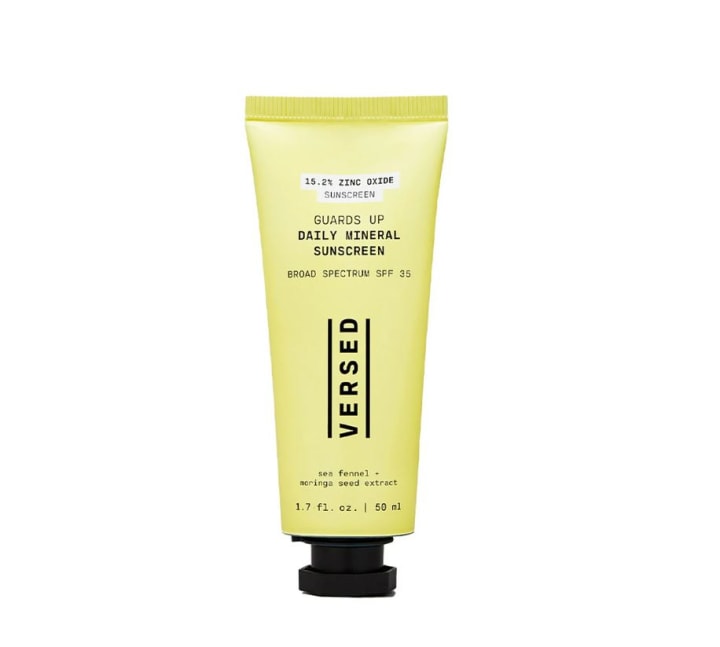Convincing your kids to slather on sunscreen can sometimes be even more challenging than getting them to eat their veggies, but it’s a necessity when it comes to protecting them from the sun’s harsh rays. And what makes it even harder is that there are so many SPF formulas to choose from. While choosing one that works best for your kids can feel overwhelming, it doesn’t have to be.
Whether you’re a seasoned parent or have just welcomed your first child, there’s a sunscreen out there to suit your family’s unique needs. To come up with our top picks, we sought out a team of skin care pros and real-life moms to share their advice and SPF product recommendations.
Consider this your comprehensive SPF shopping guide. Keep reading or use the links below to see the best sunscreens for kids, according to our sources and research.
What should I look for? | Types of sunscreens | Best overall | Best budget | Best for babies | Best for face | Best stick | Best spray | Best for eczema/sensitive skin | Best nontoxic | Best natural | Best for melanated skin | How we chose | Meet our experts
What should I look for in a sunscreen for kids?
There are a few areas you should consider before purchasing a sunscreen for your kids:
Physical vs. chemical sunscreen
When you walk down a sunscreen aisle, you’ll find two categories of products to choose from:
- Physical (aka mineral) sunscreen: This type of sunscreen uses zinc oxide and titanium oxide as their active ingredients, according to Emily Spilman, Healthy Living Science Program Manager at Environmental Working Group (EWG), a nonprofit that specializes in environmental health. These "act as physical blockers and create a barrier on skin that reflects UV rays," she adds.
- Chemical sunscreen: Chemical sunscreens, on the other hand, use ingredients like avobenzone, oxybenzone or octinoxate. These "absorb UV rays, convert it to heat and release it from the skin,” says Dr. Kiran Mian, a medical and aesthetic dermatologist.
There’s no right answer as to which type is better for children, but the pros we spoke with generally recommend physical sunscreens, saying their ingredients can be less irritating (making them ideal for sensitive skin) and aren’t absorbed into the skin.
However, board-certified dermatologist Dr. Joshua Zeichner notes that chemical sunscreens have been used for decades and are a very popular choice.
“The benefits in preventing sun damage and skin cancer from the sun outweighs any perceived safety risk. ... In my opinion, ultimately, the best sunscreen is the one you’re actually using on your skin,” says Zeichner, who's the director of cosmetic and clinical research at Mount Sinai Hospital’s department of dermatology.
Whichever sunscreen you do choose for your child, just watch out for unnecessary ingredients like fragrances, he adds.
SPF rating
The SPF (or sun protection factor) of each sunscreen varies; you’re likely to find a wide range that runs from SPF 15 to SPF 100. In general, most of us assume that a higher SPF rating offers more protection, but is there a point where the effectiveness doesn’t actually increase?
“Anything above an SPF 30 is negligibly more effective, and thicker in formulation, making it harder to use. For everyday use I like SPF 30, and for beach days or high-intensity sun days one can use an SPF 50-70 for higher protection,” Mian says.
Besides, higher SPFs can sometimes give you a "false sense of security," according to Dr. Amy Wechsler, an NYC-based board-certified dermatologist and psychiatrist.
Julie Ramos, vice president of marketing at the lifestyle brand ATTITUDE, agrees.
“People assume they’re better protected with high SPFs, so they tend to spend more time in the sun and reapply sunscreen less often, increasing the risk of sunburns, melanoma and other types of skin damage,” she tells us.
Broad spectrum
In addition to the SPF level, search for a sunscreen that offers broad spectrum protection.
“The SPF value refers to the sunscreen’s ability to protect against UVB rays, which are responsible for sunburn. The word 'spectrum' means that the sunscreen also protects against UVA rays, which are responsible for skin cancer,” Zeichner explains.
Age
Even if you have the best intentions and want to protect your newborn from the sun, the pros we polled agreed that infants shouldn’t use sunscreen because their skin is ultra-sensitive.
“You should not use sunscreen on children under the age of 6 months. During that period, they should be protected from the sun by physical methods like clothing and umbrellas,” Zeichner explains.
What are the different types of sunscreens?
With so many sunscreen formats to choose from, you might be wondering which one is best for your child. Here’s a quick breakdown of each:
- Lotions: “Lotions are nice to establish a first layer throughout areas that will soon be exposed to the sun,” says Dr. Michael C. Cameron, cosmetic and medical dermatologist at Cameron Dermatology and an assistant clinical professor of dermatology at Mount Sinai’s Icahn School of Medicine. Zeichner recommends using a quarter-sized dollop of a cream/lotion for the face, and 1 ounce (the contents of a standard shot glass) for the rest of the body.
- Sticks: Cameron says sunscreen sticks are a great options for kids and general facial application because they're often “less messy and easier for kids to use effectively.” Zeichner offers the following application tip: “Sticks should be applied back and forth for four passes to ensure that you’re depositing enough onto the skin. Make sure to rub it in afterwards.”
- Sprays: Cameron describes sprays or mists as a good option for times when you’re on-the-go and need to reapply sunscreen. Zeichner offers the following application advice: “Spray sunscreens should be held an inch from the skin and sprayed until the skin glistens. Then, it should be rubbed in to avoid any missed areas. Avoid spraying sunscreen directly into the face so it doesn’t get into the eyes, nose or mouth. Instead, spray the sunscreen into your hand and then rub it onto the face.”
As always, it’s ultimately all about what works best for you and your family, but Spilman says the EWG tends to recommend lotions or sticks as the best options for children.
“Sprays cloud the air with tiny particles that may not be safe to breathe. It can also be difficult to apply an even layer of sunscreen that is thick and uniform enough to ensure proper UV protection,” she explains.
Best sunscreen for kids overall
Thinkbaby SPF 50+ Safe Sunscreen
- Many reviewers enjoy the scent
- A bit thick for some buyers
SPF: 50 | Active ingredient: Zinc oxide | Type of protection: Physical | Application: Lotion | Water resistance: 80 min.
“This is a really great natural sunscreen for kids’ skin,” says Dr. Liia Ramachandra, a skin care expert and former pharma executive. “What I love about it is that it is a stick, so kids can easily apply it by themselves, and it is super fun.”
The No. 1 Amazon bestseller (in the Baby Sun Protection category) has garnered a staggering 15,600-plus verified five-star ratings. Its broad spectrum formula is gentle on kids’ skin and absorbs quickly without leaving behind any sticky residue.
Best budget sunscreen for kids
Babo Botanicals Sensitive Baby Mineral Sunscreen Stick
- Good coverage, no thick layer
- Some wish it was cheaper
SPF: 50 | Active ingredient: Zinc oxide | Type of protection: Physical | Application: Stick | Water resistance: 80 min.
Dr. Debra Jaliman, a New York City-based dermatologist and author of the book “Skin Rules: Trade Secrets From a Top New York Dermatologist,” enjoys this sunscreen stick and notes that it’s ideal for travel. “It’s great for babies and older kids and has safe organic ingredients,” she says.
The skin care savant particularly appreciates how easy it is to apply the stick to tricky spots, such as the ears. She describes the formula as “super hydrating.” The ingredient list — which includes jojoba oil, avocado oil and cocoa — certainly backs up her case.
Best sunscreens for babies
Babyganics Mineral-Based Baby Sunscreen
- Good for sensitive skin
- May leave a white cast behind
SPF: 50 | Active ingredients: Titanium dioxide, zinc oxide | Type of protection: Physical | Application: Lotion | Water resistance: 80 min.
Jaliman is a fan of this mineral sunscreen for a few particular reasons.
“It’s fragrance-free, non-allergenic and won’t irritate babies’ eyes,” she says.
The pediatrician- and dermatologist-tested formula offers broad spectrum protection and is free of fragrance, nanoparticles, parabens, PABA and phthalates.
Mustela SPF 50 Mineral Sunscreen
- Gentle on sensitive skin
- May leave white residue behind
SPF: 50 | Active ingredients: Zinc oxide | Type of protection: Physical | Application: Lotion | Water resistance: 80 min.
“Mustela focuses on babies, so this is my go-to,” Dr. Angela J. Lamb, a board-certified dermatologist in New York City, tells us.
The mineral sunscreen can be used for both face and body and was specifically formulated for babies’ sensitive skin. The lightweight lotion comes in a sizeable pump bottle with enough product to go around for the whole family. Luckily, it also has a sheer finish, and it even works on eczema-prone skin.
Best face sunscreen for kids
Supergoop! Sunnyscreen 100% Mineral Lotion SPF 50
- Helps nourish complexions
- On the pricier side
SPF: 50 | Active ingredient: Zinc oxide, titanium dioxide | Type of protection: Physical | Application: Lotion | Water resistance: 80 min.
Jaliman raves about this hypoallergenic mineral sunscreen that’s free of fragrances and silicone. “It has good ingredients such as oat, shea butter and fruit extracts. It’s great for children with irritated skin,” she says.
Other notable features include the hydrating formula and a non-sticky, water-resistant finish.
Best sunscreen stick for kids
Sun Bum Kids' Clear Sunscreen Face Stick
- Easy for children to apply
- Some wish product was bigger
SPF: 50 | Active ingredients: Avobenzone, homosalate, octisalate, octocrylene | Type of protection: Chemical | Application: Stick | Water resistance: 80 min.
Abbey Miller, a Massachusetts-based nurse who has two young daughters, swears by this clear sunscreen stick.
“My sister-in-law, who is a seasoned mom of two, got me into this. I have two littles, ages 4 and 2, and although they love playing in the sun, they hate staying still so I can apply sunscreen, especially to their face. This roll-on sunscreen applies easily, is totally mess-free, and my kids think it’s fun. They even want to try to put it on themselves,” she tells us.
Lamb is also a fan of the stick for one special reason: “It can be difficult to find a stick sunscreen that is also clear. This one has a nice, clean smell and is easy to apply,” she says.
Best spray sunscreen for kids
Blue Lizard Kids Mineral Sunscreen Spray
- Water-resistant formula
- Pricey if more than one needed
SPF: 50 | Active ingredient: Zinc oxide | Type of protection: Physical | Application: Spray | Water resistance: 80 min.
This mineral sunscreen offers broad spectrum protection with the help of its active ingredient: zinc oxide. It’s reef-friendly, water-resistant for up to 80 minutes, and free of parabens, gluten, alcohol and phthalates.
In addition to protecting skin from the sun, the gentle formula also treats skin to a healthy dose of antioxidants while hydrating and softening it.
Best sunscreen for kids with eczema/sensitive skin
Aveeno Kids Continuous Protection Mineral Sunscreen Lotion
- Doesn't irritate many eyes
- Some don't like the scent
SPF: 50 | Active ingredient: Zinc oxide | Type of protection: Physical | Application: Lotion | Water resistance: 80 min.
Eczema-prone and sensitive skin needs a bit of extra TLC, and this bestselling formula (it has nearly 6,000 verified five-star ratings on Amazon) seems to be up to the task. The broad spectrum sunscreen offers SPF 50 coverage for the face and body and is formulated with soothing oat.
“I personally love Aveeno, and all my kids (from age 7 to 14 years old) use it. I love it because it is mineral, great for sensitive skin, has SPF 50 and is super affordable,” Ramachandra says. As an added bonus, it’s free of fragrances, parabens and phthalate.
Best nontoxic sunscreen for kids and teens
Supergoop! Play Antioxidant Body Mist
- Broad-spectrum protection
- Resistant to water and sweat
- May feel greasy
SPF: 50 | Active ingredient: Avobenzone, homosalate, octisalate, octocrylene | Type of protection: Chemical | Application: Spray | Water resistance: 80 min.
Reef-friendly? Check. Broad spectrum? Yep! Ramachandra is a fan of this lightweight spray that tackles both UVA and UVB rays. “This is a brand I use for myself and for my kids, especially when we go swimming,” she says.
The SPF 50 formula is water and sweat-resistant up to 80 minutes and also includes antioxidant-rich vitamin C, green tea and açaí extracts that nourish and protect your skin.
“I would recommend this for a bit older kids, such as teens, due to the antioxidants present,” Ramachandra says.
Best natural sunscreens for kids
Badger Baby Mineral Sunscreen Cream
- Works well for sensitive skin
- May feel greasy when applied
SPF: 40 | Active ingredient: Zinc oxide | Type of protection: Physical | Application: Lotion | Water resistance: 40 min.
Want to protect your baby or toddler from the sun’s harsh rays — using only natural ingredients? You can rest easy while using this pediatrician-tested broad spectrum mineral sunscreen that fights off UVA and UVB rays and offers SPF 40 coverage.
The multitasker is formulated with a mix of hydrating, soothing and simple ingredients like sunflower and jojoba oils, organic chamomile and calendula. Plus, it’s reef-safe!
Even adults who have sensitive skin use this for themselves to rave reviews. One notes on Badger Balm’s website, “It is THICK, but I like that because I can feel when I’ve used enough. It also feels nice on my skin, which is sensitive and prone to eczema rashes.”
Babo Botanicals Sensitive Baby Mineral Sunscreen Lotion
- "Easy to rub in"
- A bit small for the price
SPF: 50 | Active ingredient: Zinc oxide | Type of protection: Physical | Application: Lotion | Water resistance: 80 min.
Nicole Denver, a mother of two children under the age of 3, likes to keep this sunscreen on hand for any outdoor adventures.
“I like that it is free of toxins and feels like I am protecting my babies from more than just the sun. It is mineral-based but still easy to rub in, which is an added bonus!” she explains.
The lightweight, fragrance-free formula includes 24 plant-based ingredients that join forces to offer broad spectrum SPF 50 protection, and it's ideal for sensitive skin. It’s also vegan, cruelty-free and verified as a safe option by the EWG.
Best kids' sunscreen for melanated skin
BabyDonna Sheer Mineral Sunscreen Stick SPF 35
- Product blends well
- The stick is on the smaller side
SPF: 35 | Active ingredient: Zinc oxide | Type of protection: Physical | Application: Stick | Water resistance: 80 min.
Lamb is fond of this mineral sunscreen that was created with darker skin tones in mind. Finding the right mix of protection and ease of blending is key for darker complexions, and this stick seems to have cracked the code.
It features reef-safe, non-nano zinc and several hydrating ingredients like shea butter and coconut alkanes. In addition, it offers 80 minutes of water resistance, broad spectrum protection and a travel-friendly format.
Versed Guards Up Daily Mineral Sunscreen
- Formula absorbs well
- Mixed feelings about the scent
SPF: 35 | Active ingredient: Non-nano zinc oxide, sea fennel extract, moringa seed extract | Type of protection: Physical | Application: Lotion
“This sunscreen has a peachy hue that blends in well with all skin tones and neutralizes the white cast that many mineral sunscreens are known for,” Jaliman says.
The lightweight mineral sunscreen is formulated with antioxidants that lessen the impact of environmental damage, and the broad spectrum coverage fends off both UVA and UVB rays.
How we chose the best sunscreen for kids
Your kids mean the world to you, so we took extra care while selecting our top sunscreen picks and included recommendations from the pros and real-life moms, as well as a few bestsellers that shoppers love.
While researching this guide, we consulted 11 experts and two mothers to get a well-rounded mix of opinions and also tapped into Shop TODAY’s editorial standards to ensure that you can trust these recommendations to keep your kids safe.
Meet our experts
- Dr. Mona Amin, DO, is a board-certified pediatrician, first-time mom, and host of the parenting podcast PedsDocTalk.
- Dr. Michael C. Cameron, MD, FAAD, is a cosmetic and medical dermatologist at Cameron Dermatology, as well as an assistant clinical professor of dermatology at Mount Sinai’s Icahn School of Medicine.
- Dr. Debra Jaliman, MD, is a New York City-based board-certified dermatologist and author of the book “Skin Rules: Trade Secrets From a Top New York Dermatologist.”
- Dr. Angela Lamb, MD, is a board-certified dermatologist and associate professor at Westside Mount Sinai Dermatology. She specializes in acne, hair loss, eczema, skin cancer detection and more.
- Dr. Kiran Mian, DO, FAAD, is a board-certified medical and aesthetic dermatologist. She serves patients at Hudson Dermatology & Laser Surgery in New York City.
- Dr. Liia Ramachandra, PharmD, PhD, is a skin care expert and former pharma executive.
- Julie Ramos is the vice president of marketing and communications at the lifestyle brand ATTITUDE.
- Dr. Sara Siddiqui, MD, specializes in pediatric and adolescent medicine at NYU Huntington Medical Group on Long Island.
- Emily Spilman is the Healthy Living Science Program Manager at Environmental Working Group (EWG), a nonprofit that specializes in environmental health research.
- Dr. Amy Wechsler, MD, is an NYC-based double board-certified dermatologist and psychiatrist.
- Dr. Joshua Zeichner, MD, is the director of cosmetic and clinical research in dermatology and an associate professor of dermatology at the Mount Sinai Hospital in New York City.
